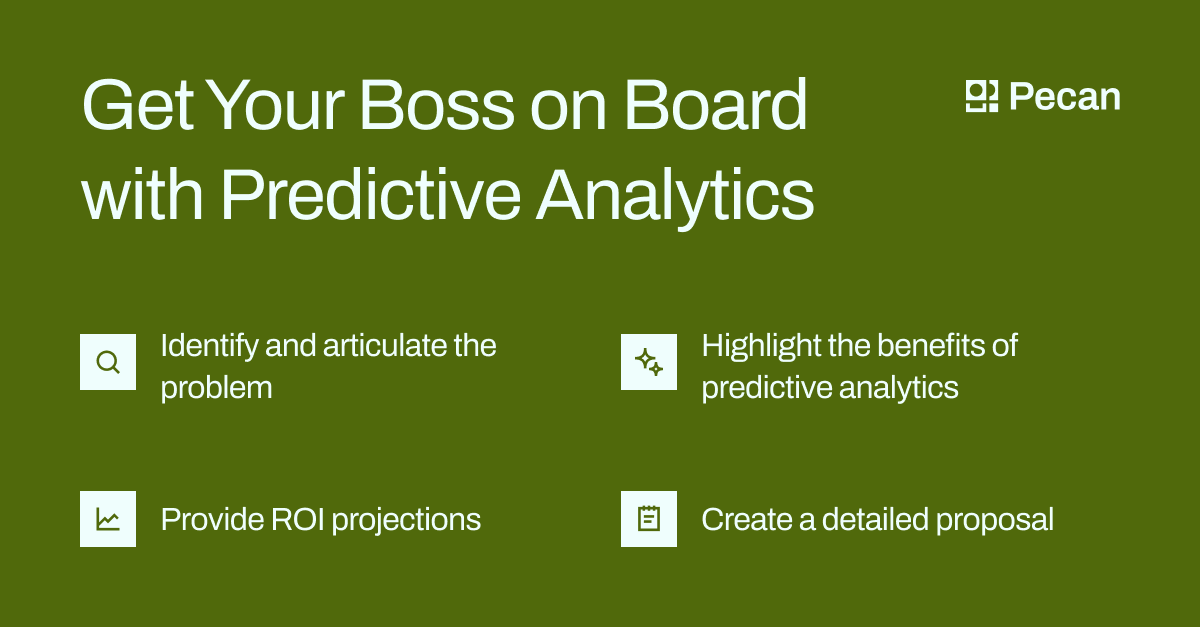In a nutshell:
- Predictive analytics is crucial for companies to stay competitive in today’s data-driven business environment.
- Convincing your boss to invest in predictive analytics can be challenging, but it’s essential to explain what it is and why it’s crucial.
- Identify the decision-maker and understand their priorities and key performance indicators (KPIs).
- Build a business case by highlighting the benefits of predictive analytics and providing ROI projections.
- Emphasize the ease of adoption and integration with existing business systems.
In today’s data-driven business environment, predictive analytics is essential for companies looking to keep or gain a competitive edge.
You can think of a company that doesn’t use predictive analytics as a boxer who enters the ring wearing a blindfold. They don’t have a clear vision of what their customers want, how to optimize their operations, or how to stay ahead of industry trends.
In contrast, a company using predictive analytics has the advantage of insights and accurate forecasts, which allows it to make strategic decisions, maximize revenue, and outmaneuver the competition.
Despite all that, convincing your boss to invest in and adopt a predictive analytics platform can be daunting, especially if they’re unfamiliar with the technology or its benefits.
As a data analyst facing that challenge, you’ll need to be able to explain what predictive analytics software is and why it’s important. To help you with the first part, we recently published “How to Get Your Boss on Board With Machine Learning.”
To answer the “why,” you’ll want to consider potential use cases for predictive analytics and their impact on your business. We’ll expand on this further in Step 3 below.
In this blog post, we’ll explore how you can strategically approach your manager and show them how investing in predictive analytics software is a worthwhile decision for your business.
Four steps to help convince your boss to adopt predictive analytics
Step 1: Identify the decision-maker
As you might expect, your first task is to identify the decision maker who must be convinced of the value of predictive analytics. If you’re integrated into a business team like marketing, sales, or distribution, that person will typically be your boss.
But suppose you’re working in a separate department (like a data center of excellence). In that case, that person may be an external department head, such as a VP of Sales, Chief Marketing Officer, or Supply Chain Manager.
Sometimes, it will simply be someone from whom your boss (or another senior manager) takes advice.
Let’s say you’re an analyst who wants to use predictive analytics to optimize your company’s massive online marketing spend. In this case, you may want to pitch the idea to a leader of performance marketing, growth initiatives, or customer acquisition, who will have no trouble visualizing and calculating the financial impact of better campaign ROI.
With your assistance, this leader will also be in a better position to pitch predictive analytics to the VP of Marketing, who might only have a basic understanding of campaign management – and thus trusts the expertise and judgment of the hired expert.
In cases where the impact is organization-wide, or your success depends on the partnership of multiple stakeholders, you may need to cast a wider net or go further up the chain of command. For example, if you want to use predictive modeling to optimize call center activity and increase customer conversions, you’ll probably need to align with multiple managers from sales, marketing, and operations.
Step 2: Understand the decision-maker
Business leaders have a lot of priorities to deal with. As our post about building a data-driven culture mentioned, predictive analytics is typically not at the top of that list. They focus on high-stakes issues such as finances, operations, and product development. In addition, many leaders have an inadequate understanding of data and how it can be used to drive business decisions.
If you’re a data analyst looking to convince your boss (or another decision-maker) to adopt predictive analytics, one of the most important things you can do is understand that person’s priorities. In particular, you should be able to identify their most important key performance indicators (KPIs) and demonstrate how predictive analytics will address them.
In the marketing domain, their KPIs might include metrics like customer acquisition cost, customer lifetime value, and campaign performance. In customer experience, key KPIs might be time on the platform, NPS score, and customer retention.
But don’t worry – you don’t need to become an expert overnight. By scheduling interviews with relevant leaders or team members, you can better understand these KPIs and how predictive analytics can help improve them.
Once you have this information, you can determine the relevant use cases and show these leaders how predictive analytics will help them make data-driven decisions – instead of relying on gut feelings, business assumptions, and overly general best practices. We’ll explore an example in the next section.
Step 3: Build the business case
Among the key benefits of predictive analytics are improved decision-making and better business outcomes (a.k.a. money!) But it’s one thing to tell and another thing to show. You’ll need to demonstrate how predictive analytics can provide actionable insights into customer behavior and other factors that drive business success.
Let’s use an example to provide you with a framework for building your own business case. Imagine you’re an analyst who wants to pursue predictive analytics as a more accurate and efficient way to improve forecasting for customer service needs. These are the steps you might take with your boss:
- Identify and articulate the problem. In this scenario, the company may struggle to effectively allocate service staff and equipment to different locations. This is resulting in increased costs, inefficiencies, and reduced customer satisfaction. Part of the problem is that the company relies on simple trends from historical data to make business decisions, which is proving inaccurate and inefficient.
- Highlight the benefits of predictive analytics. Your next step is to demonstrate how predictive analytics software can address these issues and improve the forecasting of customers’ service needs. Using the current example, you could plan for a predictive model that analyzes various data sources (such as historical call volume, customer demographics, and even weather). This model can leverage a massive volume of data to identify patterns and trends that would not be visible through traditional methods or simple hand-crafted statistical models. This would help the company anticipate customer call volume more accurately, leading to better resource allocation and improved customer satisfaction.
- Provide ROI projections. Crunching some numbers will allow you to provide a precise estimate of the return on investment (ROI) your company can expect to achieve by using predictive analytics software. This will typically include metrics like revenue, customer satisfaction, churn, inventory write-offs, call-center performance, customer acquisition costs, and so on. In the case of the Canadian Automobile Association (a travel, insurance, and roadside assistance organization), adopting predictive analytics led to a 30% reduction in time spent generating forecasts, optimized scheduling across all service facilities, and improved customer service and satisfaction – all without additional data-science resources.
- Create a detailed proposal. The last thing you may want to do is create a proposal outlining the problem, your current approach’s limitations, the benefits of predictive analytics software, and the projected ROI. This proposal could also include a plan for implementing the software, training staff, and measuring success over time – although you won’t need to do much of that when using Pecan. If you’ve done a good job up until here, it shouldn’t be much of a hard sell. But if you’ve got a lot of red tape to cut through or want to take a more formal approach, you might want to check out the article “How to Build a Business Case for Your Software.”
Step 4: Emphasize ease of adoption
The next point may be our last, but it certainly is not “least.” You may want to raise it early in the conversation with your boss. Using predictive analytics software doesn’t require the efforts of a whole team or even of a highly trained data scientist. All you need is you – a data analyst who wants to make a significant impact in your role.
To begin using predictive analytics software, all you should need to know is what data you have and where it’s stored. Pecan provides native connectors to easily connect your data sources to our machine-learning algorithms.
Through natural-language chat, Predictive GenAI guides you in defining a predictive question that can be answered with a model based on your raw data. Auto-generated SQL kickstarts your model, which the Pecan engine then automatically builds. The model uses hidden patterns in your data to generate predictions. With those predictions, you can take more informed, timely, and impactful actions.
And your raw data is all we need – Pecan automatically cleanses that data, builds features, and evaluates them for high-performing machine learning models.
Your data is automatically fed into Pecan’s AutoML system, where all the magic happens – from model building to algorithm selection to model tuning, deployment, and monitoring. This saves tremendous time and energy, and overcomes many of the most common stumbling blocks for organizations that want to adopt predictive analytics.
What your boss may be most impressed with is that you can export predictions directly into your existing business systems, such as your CRM, ERP, or BI tools. With accurate predictions integrated alongside current data, your colleagues can instantly start making better business decisions without changing how they work.
On top of that, Pecan’s dashboard communicates your model’s performance, both metrics-wise and in comparison to benchmark models, so you can quickly assess business impact. It also reveals the factors contributing to a model’s prediction and to what degree – details you can use to inform business strategy and further optimize the model.
Altogether, this makes it super easy to communicate the value of predictive analytics and the impact of your predictions. Once your first model is up and running, you can even show your data-savvy colleagues how they can tweak existing models and start experimenting with models of their own to address still more business challenges.
Ready to share the love?
By identifying the decision-makers in your company, understanding their priorities and KPIs, and demonstrating the benefits of predictive analytics, you can make a compelling business case for adopting predictive analytics. And once your leaders see results, they’ll become strong advocates for this powerful technology.
Getting up and running is easy, and we’re always here to help – whether through onboarding assistance, learning resources, product walkthroughs, our help center, and ongoing support.
Ready to get started? Then go ahead and start your free trial.








